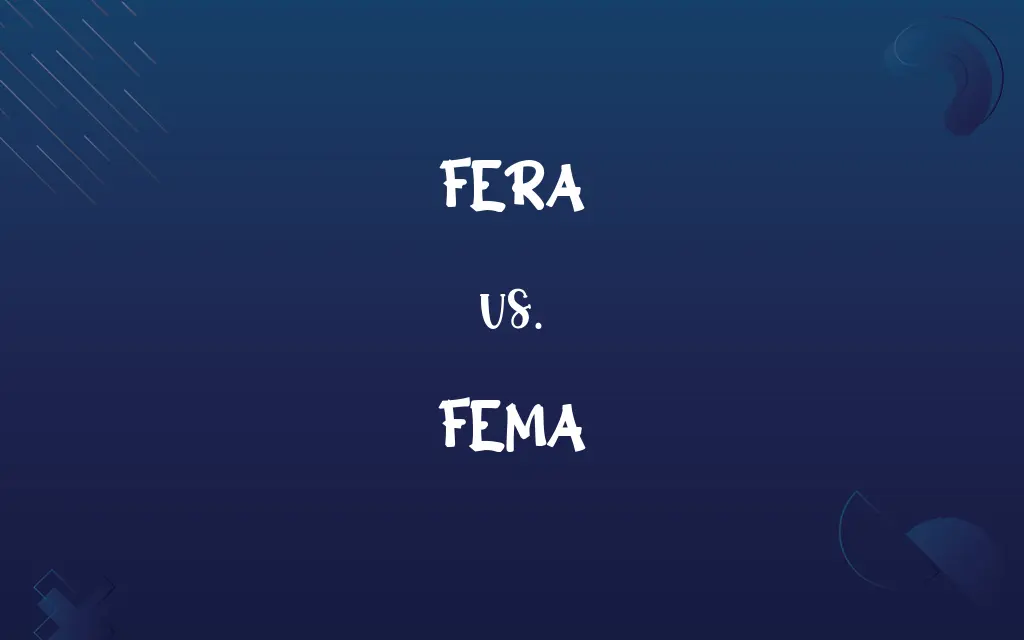FERA vs. FEMA: Know the Difference

By Shumaila Saeed || Updated on December 25, 2023
FERA (Foreign Exchange Regulation Act) was strict in regulating foreign transactions, while FEMA (Foreign Exchange Management Act) liberalized them, focusing on management and control.

Key Differences
FERA, established in 1973, was primarily a regulatory mechanism to control foreign exchange and foreign participation in Indian businesses. It was stringent in its approach, imposing strict regulations and penalties for non-compliance. FEMA, enacted in 1999, replaced FERA with a more relaxed and management-oriented approach. It aimed to facilitate external trade and payments, and to promote the orderly development and maintenance of the foreign exchange market in India.
Shumaila Saeed
Dec 10, 2023
Under FERA, foreign exchange transactions were heavily regulated, with stringent approvals needed for many types of foreign transactions. This act was seen as restrictive and created hurdles for foreign investments and transactions. FEMA, on the other hand, liberalized these transactions. It provided a framework for the Indian government to manage foreign exchange rather than to control it, thereby easing foreign trade and payments.
Shumaila Saeed
Dec 10, 2023
FERA was known for its punitive approach. Non-compliance with its provisions often led to severe penalties, including imprisonment. Its enforcement was strict, reflecting the protective economic stance of India during that period. In contrast, FEMA is less severe in terms of penalties, focusing more on the management of foreign exchange resources rather than penalizing offenders harshly.
Shumaila Saeed
Dec 10, 2023
FERA applied to all citizens of India, all branches, offices and agencies outside India owned or controlled by a person resident in India. FEMA, in contrast, is more specific in its application, primarily focusing on all transactions involving foreign exchange or foreign security and the responsibilities of residents and non-residents in India.
Shumaila Saeed
Dec 10, 2023
The scope of FERA was broad, covering all aspects of foreign exchange, including employment of foreign personnel. FEMA streamlined the process, focusing mainly on transactions related to foreign exchange, thus simplifying foreign trade and payment processes.
Shumaila Saeed
Dec 10, 2023
ADVERTISEMENT
Comparison Chart
Penalties for Non-Compliance
Severe, including imprisonment
Less severe, more management-focused
Shumaila Saeed
Dec 10, 2023
Scope of Application
Broad, including employment of foreign personnel
Specific to foreign exchange transactions
Shumaila Saeed
Dec 10, 2023
ADVERTISEMENT
FERA and FEMA Definitions
FERA
The act applied to all Indian citizens and Indian-owned businesses abroad.
Even Indian companies operating overseas were subject to FERA regulations.
Shumaila Saeed
Dec 04, 2023
FEMA
FEMA reduced the restrictions on foreign exchange transactions.
Under FEMA, obtaining foreign currency for business purposes became more straightforward.
Shumaila Saeed
Dec 04, 2023
FERA
FERA was seen as a barrier to foreign investment and trade.
Many foreign investors were hesitant to enter the Indian market due to the restrictions imposed by FERA.
Shumaila Saeed
Dec 04, 2023
FEMA
The act encourages the orderly development of the foreign exchange market.
FEMA played a significant role in developing India's foreign exchange market.
Shumaila Saeed
Dec 04, 2023
FERA
FERA aimed to conserve India's foreign exchange resources.
FERA's stringent rules were in place to prevent the outflow of foreign currency.
Shumaila Saeed
Dec 04, 2023
ADVERTISEMENT
FEMA
FEMA is a law that liberalizes foreign exchange management in India.
With the introduction of FEMA, foreign investors found it easier to conduct business in India.
Shumaila Saeed
Dec 04, 2023
FERA
FERA was a regulatory law governing foreign exchange in India.
Under FERA, businesses had to obtain specific permissions to engage in certain foreign exchange transactions.
Shumaila Saeed
Dec 04, 2023
FEMA
FEMA focuses on facilitating external trade and payments.
FEMA streamlined the process for Indian companies to engage in international trade.
Shumaila Saeed
Dec 04, 2023
FERA
FERA imposed strict penalties for violations, including imprisonment.
Violating FERA rules could lead to harsh legal consequences.
Shumaila Saeed
Dec 04, 2023
FEMA
FEMA's penalties for non-compliance are less severe compared to FERA.
FEMA's approach towards violations is more focused on management rather than punishment.
Shumaila Saeed
Dec 04, 2023
FEMA
An independent agency of the United States government that provides a single point of accountability for all federal emergency preparedness and mitigation and response activities
Shumaila Saeed
Dec 01, 2023
Repeatedly Asked Queries
How did FEMA change the approach towards foreign exchange?
FEMA liberalized the approach, focusing on management and facilitation of foreign exchange.
Shumaila Saeed
Dec 10, 2023
What was the main purpose of FERA?
FERA was enacted to regulate and control foreign exchange in India.
Shumaila Saeed
Dec 10, 2023
Can violations under FEMA lead to imprisonment?
Generally, FEMA focuses on financial penalties rather than imprisonment.
Shumaila Saeed
Dec 10, 2023
What is the significant difference in penalties under FERA and FEMA?
FERA had harsher penalties, including imprisonment, while FEMA's penalties are more lenient.
Shumaila Saeed
Dec 10, 2023
Were foreign exchange transactions easy under FERA?
No, FERA made foreign exchange transactions complex and restrictive.
Shumaila Saeed
Dec 10, 2023
Were individuals affected by FERA regulations?
Yes, FERA applied to all Indian citizens, affecting their foreign transactions.
Shumaila Saeed
Dec 10, 2023
Does FEMA encourage foreign investment?
Yes, by liberalizing foreign exchange management, FEMA encourages foreign investment.
Shumaila Saeed
Dec 10, 2023
Was FERA restrictive for Indian businesses abroad?
Yes, FERA imposed regulations on Indian businesses operating overseas.
Shumaila Saeed
Dec 10, 2023
How does FEMA impact foreign trade?
FEMA simplifies and facilitates foreign trade for Indian companies.
Shumaila Saeed
Dec 10, 2023
Were technology transfers affected by FERA?
Yes, FERA controlled and regulated technology transfers involving foreign exchange.
Shumaila Saeed
Dec 10, 2023
Did FERA apply to non-resident Indians?
Yes, FERA regulations also applied to non-resident Indians.
Shumaila Saeed
Dec 10, 2023
How do the objectives of FERA and FEMA differ?
FERA's objective was to control and conserve foreign exchange, while FEMA's is to manage and facilitate it.
Shumaila Saeed
Dec 10, 2023
Is FEMA more business-friendly than FERA?
Yes, FEMA is considered more business-friendly, with its liberalized norms.
Shumaila Saeed
Dec 10, 2023
Did FERA impact foreign currency outflow?
Yes, FERA aimed to control and minimize the outflow of foreign currency.
Shumaila Saeed
Dec 10, 2023
Did FERA contribute to a closed economy in India?
FERA's restrictive nature contributed to India's closed economic stance during its enforcement period.
Shumaila Saeed
Dec 10, 2023
How has FEMA influenced India's integration into the global economy?
FEMA has facilitated India's integration into the global economy by easing foreign exchange regulations.
Shumaila Saeed
Dec 10, 2023
How does FEMA benefit individual foreign exchange transactions?
FEMA eases foreign exchange transactions for individuals, making them less cumbersome.
Shumaila Saeed
Dec 10, 2023
What type of transactions does FEMA primarily focus on?
FEMA primarily focuses on transactions involving foreign exchange or foreign security.
Shumaila Saeed
Dec 10, 2023
Was obtaining foreign investment easier under FEMA than FERA?
Yes, FEMA made obtaining foreign investment simpler compared to FERA.
Shumaila Saeed
Dec 10, 2023
Are current foreign exchange transactions in India governed by FERA or FEMA?
Current foreign exchange transactions in India are governed by FEMA.
Shumaila Saeed
Dec 10, 2023
Share this page
Link for your blog / website
HTML
Link to share via messenger
About Author
Written by
Shumaila SaeedShumaila Saeed, an expert content creator with 6 years of experience, specializes in distilling complex topics into easily digestible comparisons, shining a light on the nuances that both inform and educate readers with clarity and accuracy.








































































